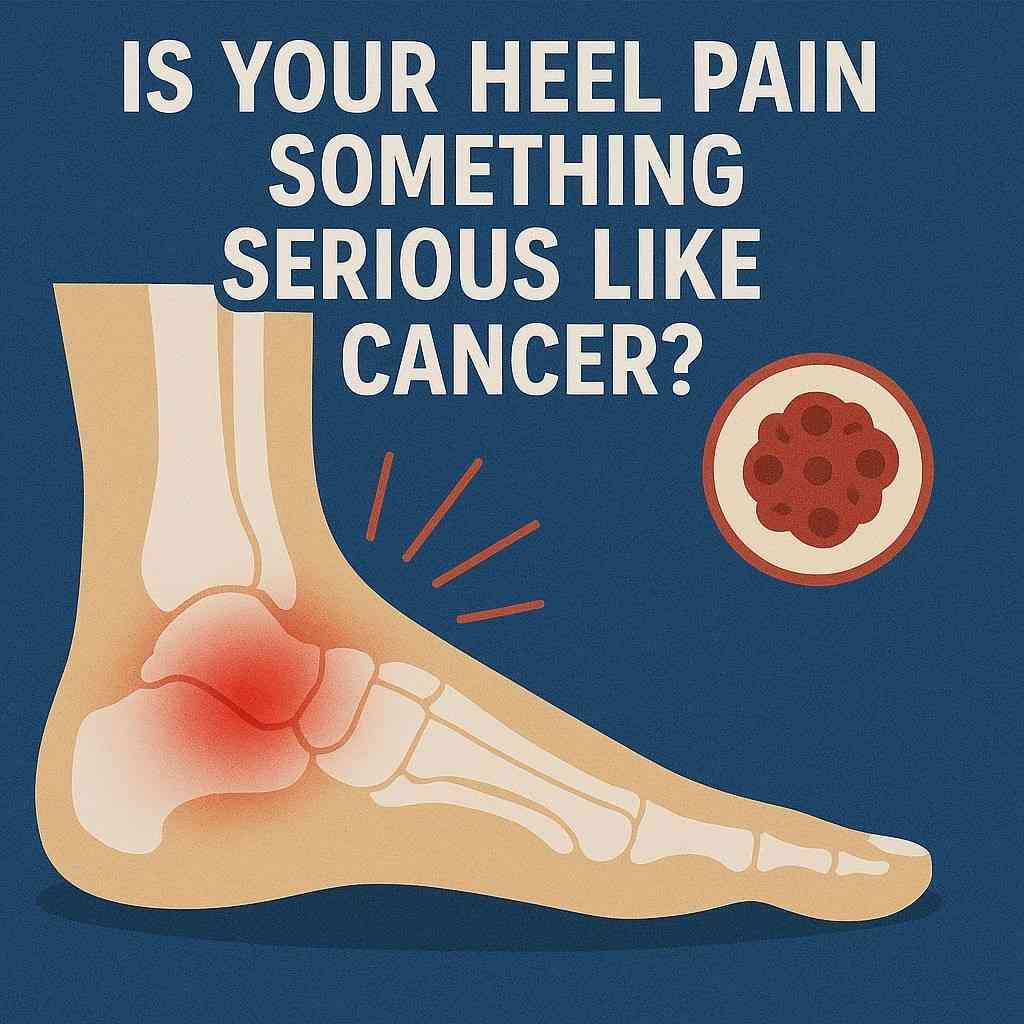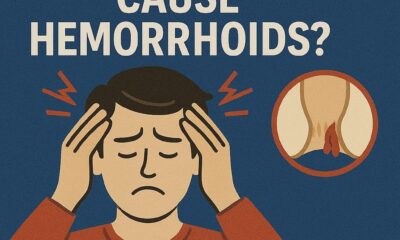General Health & Wellness
Is Your Unusual Heel Pain a Scary Serious Problem?
Heel pain is usually harmless but can sometimes signal cancer. Learn the warning signs, when to see a doctor, and the best treatment options available.

A large number of people globally report having heel pain. Conditions including plantar fasciitis, Achilles tendonitis or a simple hurt can bring about heel pain. Even so, it is normal for people to wonder if heel pain could point to a more serious problem such as cancer. The goal of this blog is to make heel pain easier to understand and to outline when this pain might be a cause for concern, as well as how it is related to cancer.
What Makes Heel Pain Happen?
Before we look at the cancer connection, it’s necessary to understand what usually causes heel pain. The majority of heel pain is caused by issues such as strain or inflammation.
Plantar Fasciitis
Most heel pain happens because of the plantar fascia, a link between the heel and toes—becomes inflamed. There is usually a sharp pain in the sole of the foot first thing after getting out of bed.
Achilles Tendonitis
Inflammation of the Achilles tendon which attaches the calf muscles to the heel, is what this condition is about. Most often, pain is felt at the back of the heel and grows worse during physical activity.
Heel Spurs
There are times when an extra growth called a heel spur can appear on the heel bone connected to plantar fasciitis and create pain in just one spot at the heel.
Bursitis
A bursa infection by the heel may cause pain and make your heel feel swollen.
Stress fractures or damage to the bone
If your heel is injured over and over, it may eventually fracture and cause lasting pain.
Is Heel Pain a Sign of Cancer?
Normally, heel pain has nothing to do with cancer. Most cases of heel pain are caused by things like those I described above. That said, cancer may be a factor when a tumor appears in the bones or muscles of the foot or heel, but this is uncommon.
Bone Cancer and Pain in the Heel
A heel bone (calcaneus) primary bone cancer such as osteosarcoma or Ewing’s sarcoma is extremely uncommon. When cancer develops in the heel bone, you might experience:
- Having heel pain that doesn’t go away after taking breaks
- A lump or swelling close to the heel
- Pain that happens at night keeps you from sleeping through the night
- Losing or feeling tired for no reason
Metastatic Cancer
When cancer spreads from elsewhere in the body to the bones, it can sometimes create pain in the heel. It is possible when cancer cells wander through the body and develop new clusters in the heel bone or close by tissues. While rare, if the cancer metastasizes in the heel area, patients may also have general unwellness, bone tenderness, visible swelling or even a broken heel caused by weak bones. Most of these additional signs help to identify cancer-related heel pain from other kinds of pain.
When to See a Doctor About Heel Pain
Since heel pain caused by cancer is unusual, most cases can be treated without surgery. Even so, you should get checked by a doctor if you notice any of these symptoms.
- You have had heel pain that hasn’t been resolved for several weeks
- The pain is often more severe when people lie down or sleep at night.
- You might discover your heel is swollen, red or has a lump on it
- Unexplained weight loss and fatigue occur for you.
- You experienced cancer in the past and got new heel pain
Promptly seeing a doctor can help tell if there is a serious problem and can lead to the right course of treatment.
Diagnosing the Cause of Heel Pain
Most health practitioners discover the factors behind heel pain by:
- The review includes chatting about symptoms, any past injury and examining the patient’s foot.
- Using X-rays, MRI or CT scans, doctors can discover if the person has fractures, tumors or inflammation.
- If cancer is suspected in rare cases, a piece of the tissue might be examined in a biopsy.
The right diagnosis is necessary to choose the best way to treat the patient.
Treatment Options for Heel Pain
Depending on the reason for the condition, treatment usually involves:
- Resting and using an ice pack can both make inflammation less damaging to your tendon.
- Strength and stretch exercises for your feet and calves are important as part of your physical therapy program.
- Orthotics are used as shoe inserts or heel cups to provide help for the foot and lessen pressure.
- Prescribed drugs typically include anti-inflammatory drugs , painkillers or herbs.
- Recommending injections: Corticosteroids for people suffering from severe joint inflammation.
- Less common than other approaches, surgery may be offered when standard treatments don’t work, or tumors are found.
After being diagnosed with cancer, doctors may recommend surgery, chemotherapy or radiation, along with help from oncologists.
Preventing Heel Pain
Preventing all heel pain is impossible, though you can reduce your chances by:
- Make sure your shoes have good arch support and are the correct fitting for you.
- Try to reduce continually putting pressure on your feet.
- Blindness reduces the risk of weight gain
- Frequent stretching before and after you exercise
- Take care of foot injuries as soon as you notice them
Conclusion: Heel Pain and Cancer—What You Need to Know
All things considered; heel pain is nearly never a sign of cancer. Usually, heel pain is due to easily treatable issues such as plantar fasciitis, tendonitis, heel spurs or bursitis. Most of these problems get better when you rest, do physical therapy and use other conservative methods. But if your heel pain continues and you also notice swelling, lumps, nighttime pain, unexplained weight loss or tiredness, visit your healthcare professional. Early recognition of a serious condition helps control it better. If your heel pain doesn’t go away or feels unusual to you, it’s important to see a healthcare professional as soon as possible.
Call to Action (CTA) – Contact your healthcare provider today
If you keep having heel pain or find swelling, lumps or feel discomfort at night, don’t just ignore your symptoms. Listening to your symptoms and looking at your overall health is necessary to find potentially severe health problems and the correct treatment. Talk to your health professional today to explain your symptoms and get treatment.
Revised Frequently Asked Questions (FAQs)
1. Can cancer cause heel pain?
It doesn’t happen very often, but it can take place. Usually, heel pain results from harmless reasons, but occasionally bones tumors or cancer spreading to the heel can cause discomfort
2. What are the warning signs that heel pain might be cancer-related?
Some warning signs are constant or worsening heel pain, lumps or swelling next to the heel, pain that gets worse at night, unexplained weight loss and feeling tired all the time.
3. How do doctors diagnose cancer-related heel pain?
A physician might assess your condition with a physical exam, imaging tests and on rare occasions, a biopsy.
4. How common is cancer in the heel bone?
Heel bone cancer is a rare condition. Most heel pain is the result of common conditions such as plantar fasciitis or tendonitis.
5. When should I see a doctor about my heel pain?
If the pain in your heel lasts more than a couple of weeks, hurts worse at night or you have swelling, lumps or lose weight without knowing why, see a doctor right away.
6. Can stress fractures cause heel pain?
Repeating the same action over time or getting an injury can result in very small bone cracks in the heel which cause pain.
7. Are heel spurs cancerous?
No, Heel spurs are safe bone growth and do not cause cancer.
8. What treatment options are available for heel pain?
The treatment options are rest, ice, physical therapy, orthotic supports, medications, injections with corticosteroids and, not commonly, surgery. If cancer appears, you will need treatments from an oncologist.
-

 General Health & Wellness2 months ago
General Health & Wellness2 months agoCan Stress Cause Hemorrhoids? Myth or Medical Reality?
-

 Men & Women's Health2 months ago
Men & Women's Health2 months agoLatest Types of Braces: Unexpected Costs, Benefits & Best Treatments
-

 Mental Health2 months ago
Mental Health2 months agoThe Silent Panic Attack Trap That’s Hurting Millions Now
-

 Diet & Nutrition2 months ago
Diet & Nutrition2 months agoRare Lemon Balm Benefits That Will Calm Your Mind & Heart
-

 Diet & Nutrition3 months ago
Diet & Nutrition3 months agoHow to Make a Lemon Balm Tea for Effective Weight Loss
-

 Men & Women's Health3 months ago
Men & Women's Health3 months agoComplete Truth About Lingual Braces Costs, Benefits And Care
-

 Recipes3 months ago
Recipes3 months agoHow to Make Melissa Tea at Home: A Step-by-Step Guide
-

 Diet & Nutrition4 months ago
Diet & Nutrition4 months agoWhite Grapes Vs Red Grapes: Which Is Better for Your Health








































